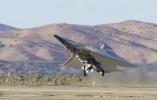נאסא'ס שטילע סופערסאניק דזשעט פליט ארויף אויף.


PALMDALE, CALIFORNIA — In a milestone for aviation history, NASA’s experimental X-59 supersonic jet has successfully broken the sound barrier — but this time, without the deafening sonic boom. The sleek, needle-nosed aircraft, developed by Lockheed Martin’s legendary Skunk Works division, completed its first test flight from Air Force Plant 42 in Palmdale, California, marking a major breakthrough in quiet supersonic technology.
The X-59, designed to cruise at 55,000 feet and reach speeds up to 925 miles per hour, is part of NASA’s “Quiet Supersonic Technology” (QueSST) program aimed at revolutionizing commercial air travel. Instead of producing the explosive shockwave associated with supersonic flight, the aircraft emits a soft “thump” — a sound gentle enough to potentially allow future overland supersonic travel.
For decades, commercial supersonic flight has been banned over land due to the disruptive noise caused by sonic booms. NASA’s successful test signals a turning point that could one day make cross-country flights dramatically faster, connecting New York to Los Angeles in less than three hours without disturbing communities below.
Lockheed Martin engineers credited the X-59’s unique design — featuring an extended nose, offset cockpit, and carefully shaped fuselage — for dispersing shockwaves and reducing sound intensity. “What we’re witnessing today could redefine air travel for generations,” a NASA spokesperson said following the test.
President Trump has repeatedly voiced support for advancing U.S. aerospace innovation, with his administration investing heavily in domestic research, manufacturing, and defense technologies. The X-59’s success is being hailed as another example of American engineering leadership on the global stage.
As the aircraft undergoes additional testing throughout 2026, NASA plans to conduct community sound trials to measure public response to the jet’s quiet supersonic signature — paving the way for future regulatory changes that could bring commercial supersonic flights back to U.S. skies.
גאלערי
ווידעאס